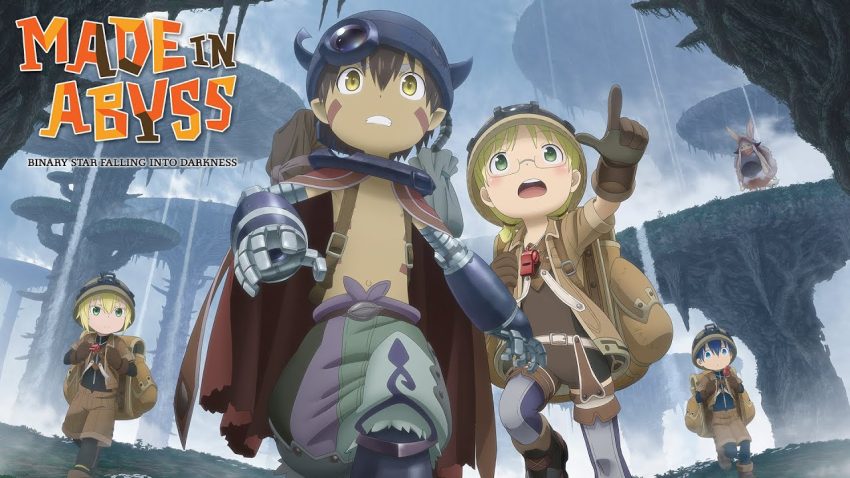For Made in Abyss: Binary Star Falling into Darkness players, this guide is a notebook entry and rough location of the various creatures of the Abyss.
Foreword
The presentation and descriptions of locations for creatures in this guide may not be the best, but hopefully they will help aspiring delvers find the missing entries they need to complete their notebook.
Be forewarned, some entries are definitive spoilers for later areas in the game, so be advised. I will leave the best way to encounter them in spoilers, just in case you’d still like to find them yourselves, but want to know what the missing entries are.
Man-toyer
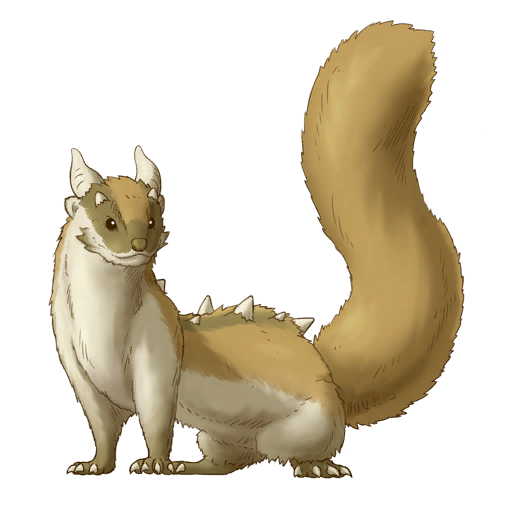
Though it looks like a weasel, it has spikes on its head, back and hips.
It has a fluffy tail as thick and long as its body. When attacked, it drives the attacker to hit its tail, preventing damage to its body.
It moves about in large groups. While in the grassy areas, its tail resembles another plant.
It is very aggressive when it comes to its territory. It will charge at anyone who comes close.
Its favorite food is fruit. The horn can be easily process and used as a bullet.
Location: Immediately upon embarking from the surface, it is impossible to miss these little slippery mustelids.
Man-toyer (Rare)
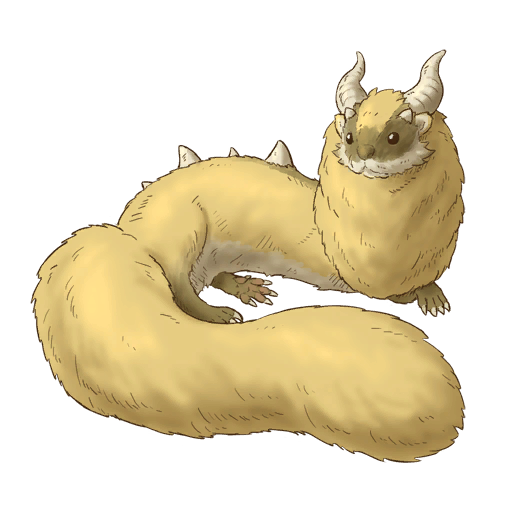 Male man-toyers rarely appear in front of people, and are known to be rather scarce.
Male man-toyers rarely appear in front of people, and are known to be rather scarce.
The females have much larger horns on their heads and thicker fur, and are also bigger in size.
Location: Once unlocked, Nanachi’s garden (inbetween her home and the Hidden Hot Spring transition), there will often be one here, amongst regular man-toyers.
Strength-sucker
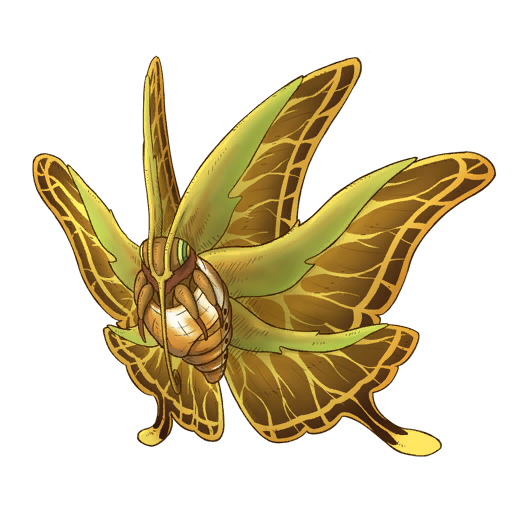
It looks similar to the Pupa-carrier, but is a different species. It loves the smell of excrement, and will gather to that scent anywhere in the Abyss.
By swarming around a target they can force it to expend an abnormal amount of energy. They must be dealt with quickly before you lose consciousness.
Location: Whenever you go to climb walls, they have a tendency to appear after a short while. They’re rather hard to miss.
Vine-stopper
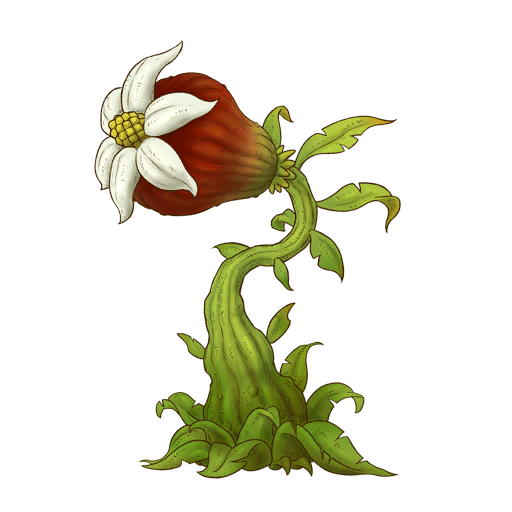
A plant that shoots out seeds similar to cannonballs. The seeds fragment wherever they land, making it highly dangerous.
There are many variants found in each layer, including some which are reported to launch highly poisonous seeds.
They got their name because when encountered, Cave Raiders were often stopped in their tracks. They are also known as “Time-wasters.”
Location: Some appear in the 1st layer, in Grand Bridge Way for example, but plenty spawn in the 2nd layer as well as the other variants afterwards.
Stinger
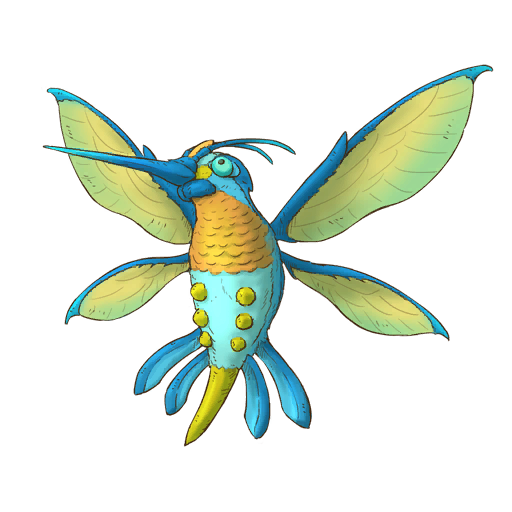
It appears to be a cross between a bird and a bug. It flaps its wing so fast they cannot be seen as it glides. It will fly at an uncanny speed in the pursuit of prey.
The part that looks like a beak is actually a very sharp horn. It can pierce as well as cut through flesh.
It is unable to change directions while rushing at its prey, which may cause it to crash into trees or rocks. It often gets eaten by other creatures when stuck in this way.
It stabs its food with its horn to carry it back to its nest before eating. Its mouth is slightly below the base of the horn.
It is barely edible and its meat is hard too.
Location: Frequently throughout the 1st Layer’s areas, and can be a pest whilst trying to climb walls.
Stinger (Ancestor)
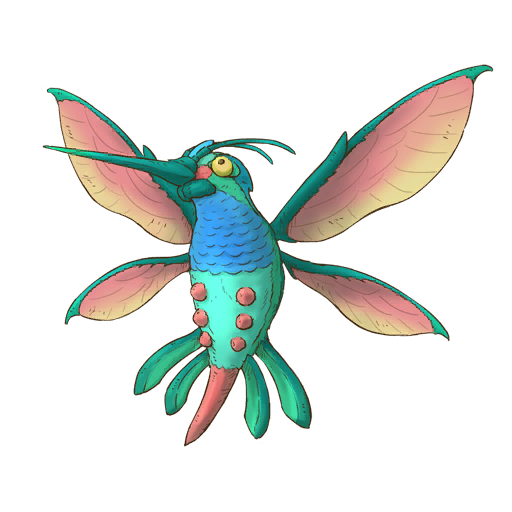
It appears to be a cross between a bird and a bug. It flaps its wing so fast they cannot be seen as it glides. It will fly at an uncanny speed in the pursuit of prey.
The part that looks like a beak is actually a very sharp horn. It can pierce as well as cut through flesh.
It is unable to change directions while rushing at its prey, which may cause it to crash into trees or rocks. It often gets eaten by other creatures when stuck in this way.
It stabs its food with its horn to carry it back to its nest before eating. Its mouth is slightly below the base of the horn.
It is barely edible and its meat is hard too.
Location: Similar to those in the 1st layer, these can be found interspersed in the areas (notably the Forest of Temptation and Corpse-Weeper Den in particular.)
Stinger (Subspecies)
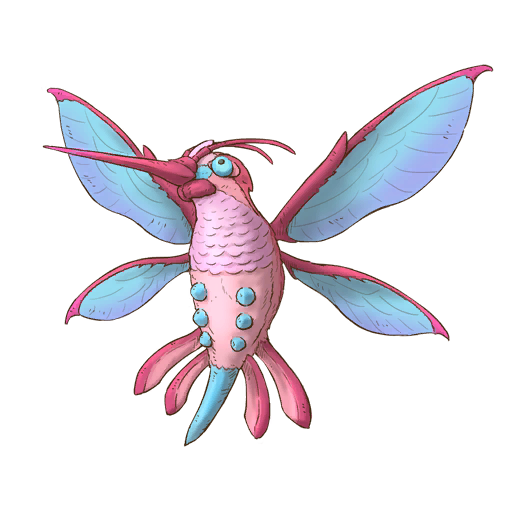
It appears to be a cross between a bird and a bug. It flaps its wing so fast they cannot be seen as it glides. It will fly at an uncanny speed in the pursuit of prey.
The part that looks like a beak is actually a very sharp horn. It can pierce as well as cut through flesh.
It is unable to change directions while rushing at its prey, which may cause it to crash into trees or rocks. It often gets eaten by other creatures when stuck in this way.
It stabs its food with its horn to carry it back to its nest before eating. Its mouth is slightly below the base of the horn.
It is barely edible and its meat is hard too.
Location: Often throughout the 4th layer, but notably around the Light-eaters in Floating Rocks and Crystal Valley, as well.
Hammerbeak
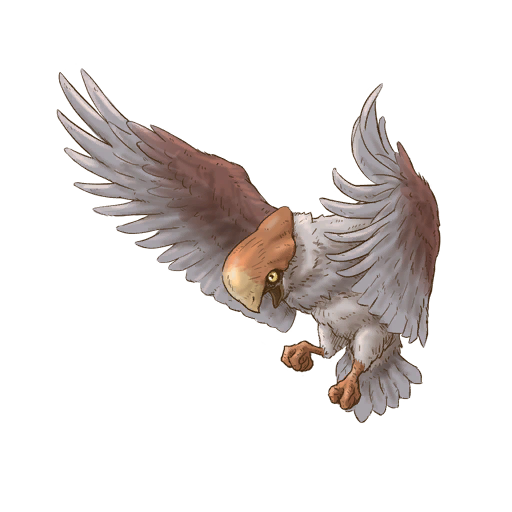
A bird that inhabits a wide range, from the surface to the fourth layer of the Abyss. It has a hard skull that is fused with its beak. Its wingspan is over three meters long.
Males clash with each other using their skulls. The impact of their skulls can literally cause sparks to fly.
Its meat is delicious and prized among Cave Raiders. The skull can be used as a fire starter, cooking utensils, and a bowl. It is said that one of these is enough for all your cooking needs.
Its feather can be used as high-quality kindling.
Location: Often spawn in Grand Bridge Way and the Multilayer Hill areas, circling above open ground.
Tachikanata
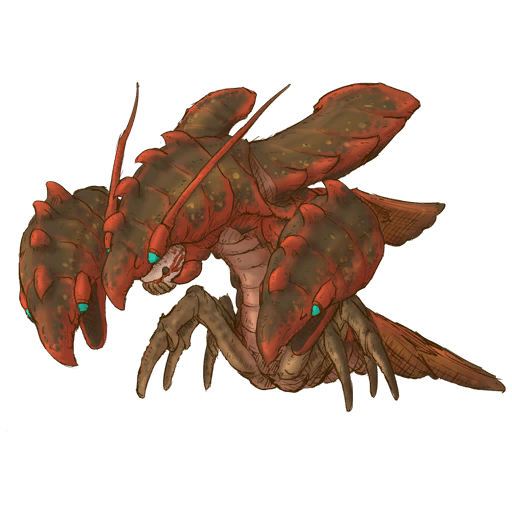
Its head and arms are similar shapes, and its mouth opens and closes like a pincer. This causes it to appear as though it has three heads.
It is covered with a shell and fins, making it extremely sturdy.
It has pincers on its back that can clamp down hard, creating a shockwave over a wide area.
It hunts using the shockwave to knock out prey.
However, its most dangerous feature is the shockwave that comes from both its pincers.
Its power is said to even sever the sky.
As expected from its appearance, it is delicious.
While its head is the hardest part of its body, its lower portion is not covered by shell, exposing its soft parts.
The aftershocks from the pincer on its back can cause concussions.
Location: One of these can randomly spawn on the inside of the stone ark in the Stone Ark area of the 1st Layer. Another can spawn in the lake at Wind-Riding Windmill.
Tachikanata (Azure)
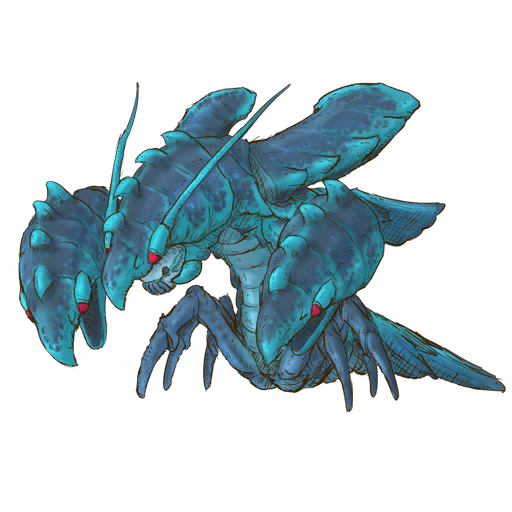
Its head and arms are similar shapes, and its mouth opens and closes like a pincer. This causes it to appear as though it has three heads.
It is covered with a shell and fins, making it extremely sturdy.
It has pincers on its back that can clamp down hard, creating a shockwave over a wide area.
It hunts using the shockwave to knock out prey.
However, its most dangerous feature is the shockwave that comes from both its pincers.
Its power is said to even sever the sky.
As expected from its appearance, it is delicious.
While its head is the hardest part of its body, its lower portion is not covered by shell, exposing its soft parts.
The aftershocks from the pincer on its back can cause concussions.
Location: Within the 2nd layer, it’ll sometimes appear in the large platforms around the upside forest areas. They can also appear in the terminal pond.
Tachikanata (Ancestor)
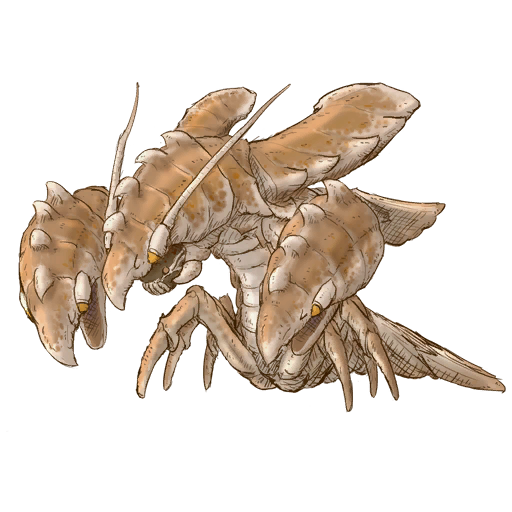
Its head and arms are similar shapes, and its mouth opens and closes like a pincer. This causes it to appear as though it has three heads.It is covered with a shell and fins, making it extremely sturdy.It has pincers on its back that can clamp down hard, creating a shockwave over a wide area.
It hunts using the shockwave to knock out prey.
However, its most dangerous feature is the shockwave that comes from both its pincers.
Its power is said to even sever the sky.
As expected from its appearance, it is delicious.
While its head is the hardest part of its body, its lower portion is not covered by shell, exposing its soft parts.
The aftershocks from the pincer on its back can cause concussions.
Location: Within the 3rd Layer, they appear in the open portions of the glass layer while descending from the uppermost entrances.
Tachikanata (Young)
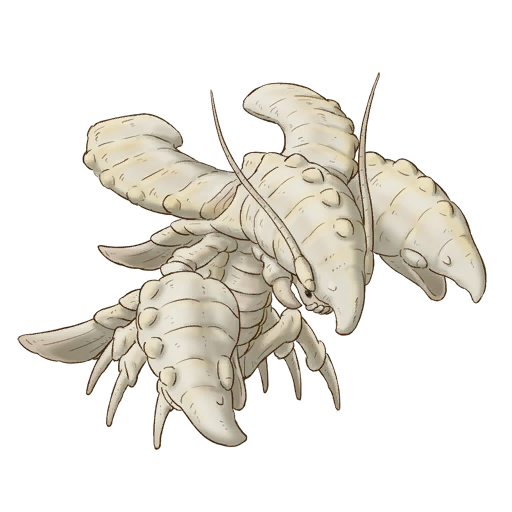
A young tachikanata looks exactly like its parents. Its color depends on its diet. It is white at a young age and the shell is rather soft.
Location: Within the 1st Layer, you can see these in the fishing pools around the areas, in particular next to the waterfall on twin falls.
Horncrier
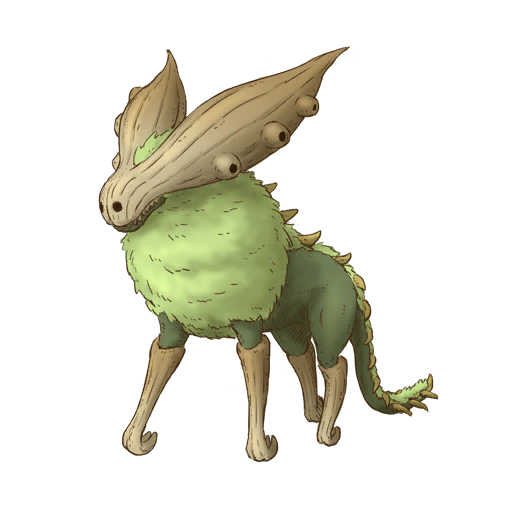
Its head is covered in horns. It has no eyes and its ears are infused to its horns. The nostrils are mistaken for eyes.
Much of its horns are are hollow, and by breathing through its nostrils it creates a special sound. It uses the echo from its horns to survey its surroundings, so it remains dormant during rainy days.
It has an unnecessarily long tail that drags behind it.
It uses its horns and legs to gore an opponent. Its powerful hind legs kick at those who circle around it.
Its horns are actually its weak point, so frontal attacks to its head are highly effective. (Granted, one must be brave enough and able to do so.)
Its horn can be processed into musical instruments.
Location: A few show up throughout the 1st layer, especially in near the entrance to the 2nd Layer.
Horncrier (Ancestor)
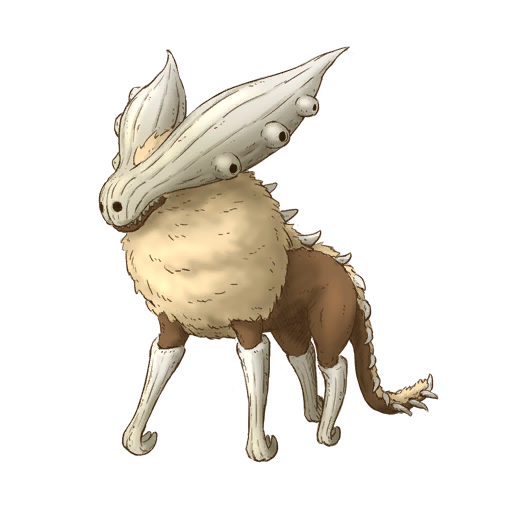
Its head is covered in horns. It has no eyes and its ears are infused to its horns. The nostrils are mistaken for eyes.
Much of its horns are are hollow, and by breathing through its nostrils it creates a special sound. It uses the echo from its horns to survey its surroundings, so it remains dormant during rainy days.
It has an unnecessarily long tail that drags behind it.
It uses its horns and legs to gore an opponent. Its powerful hind legs kick at those who circle around it.
Its horns are actually its weak point, so frontal attacks to its head are highly effective. (Granted, one must be brave enough and able to do so.)
Its horn can be processed into musical instruments.
Location: In the Corpse-weeper Den, down the cliff next to where the Corpse-weepers circle in the air at the entrance to Inverted Forest, these will roam in a small amount.
Horncrier (Subspecies)
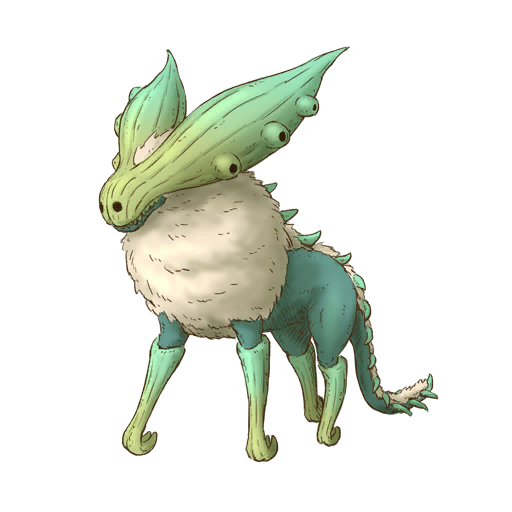
Its head is covered in horns. It has no eyes and its ears are infused to its horns. The nostrils are mistaken for eyes.
Much of its horns are are hollow, and by breathing through its nostrils it creates a special sound. It uses the echo from its horns to survey its surroundings, so it remains dormant during rainy days.
It has an unnecessarily long tail that drags behind it.
It uses its horns and legs to gore an opponent. Its powerful hind legs kick at those who circle around it.
Its horns are actually its weak point, so frontal attacks to its head are highly effective. (Granted, one must be brave enough and able to do so.)
Its horn can be processed into musical instruments.
Location: In the 4th layer, while proceeding through the vine bridge, these will spawn often in the area in small groups, usually.
Silkfang
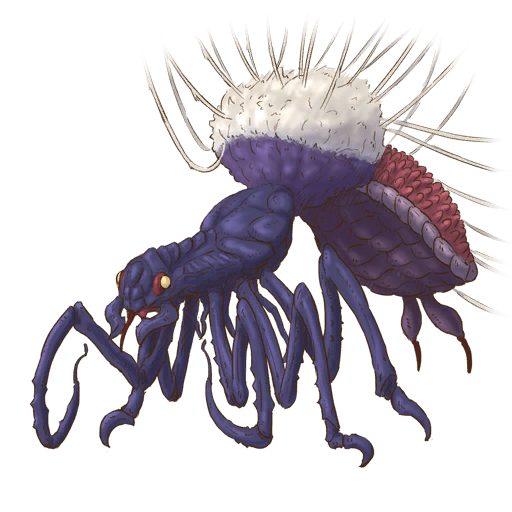
A large bug that inhabits the first layer of the Abyss. It creates a dome-like territory for itself about 10-meters wide, and ambushes its prey inside it using sticky, tactile hair.
It moves extremely fast within its territory, but it doesn’t react to anything outside of it. Its behavior is very distinct in this way.
It rests atop the dome nest until prey enters its territory.
Its snout has a poisonous sting that can paralyze. It is unknown if it can be consumed.
Location: Once progressed far enough, these have a chance to spawn in a few maps of the 1st layer, their appearance signaled by a distant thumping noise you can hear quite easily.
Sakawatari
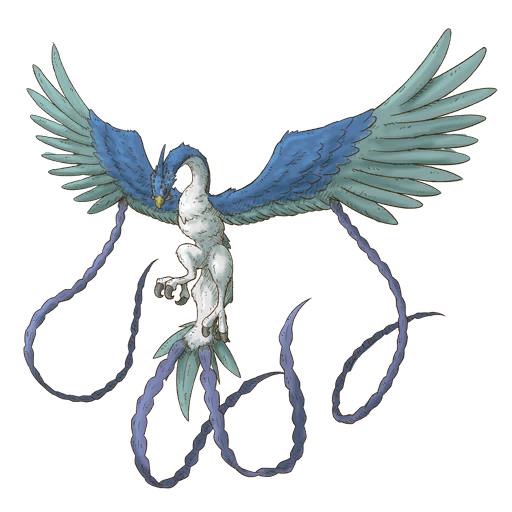
A giant bird with blue wings. It is said to live in the deepest parts of the Abyss, and can cross through the acension strains that cause death.
This creature was described in murals and legends before its existence was confirmed when it appeared near the surface in recent years.
Murals and legends claim it appears once every 2000 years, and is believed that the end of the cycle is approaching. On the murals, it is rumored to be the same creature from the one 2000 years ago.
Location: Within the 1st Layer, at twin falls, this can be seen circling high in the air over the abyss, far out of reach. By climbing onto a tall structure and using a telescope (not the monocle), you can scan this bird as it circles about.
Akatsutsuso

A plant that shoots out seeds similar to cannonballs. The seeds fragment wherever they land, making it highly dangerous.
There are many variants found in each layer, including some which are reported to launch highly poisonous seeds.
They got their name because when encountered, Cave Raiders were often stopped in their tracks. They are also known as “Time-wasters.”
Location: Similar to those of the 1st Layer, these will begin to appear instead throughout some areas of the 2nd and 4th layers, rarely alongside the blue variety.
Aotsutsuso
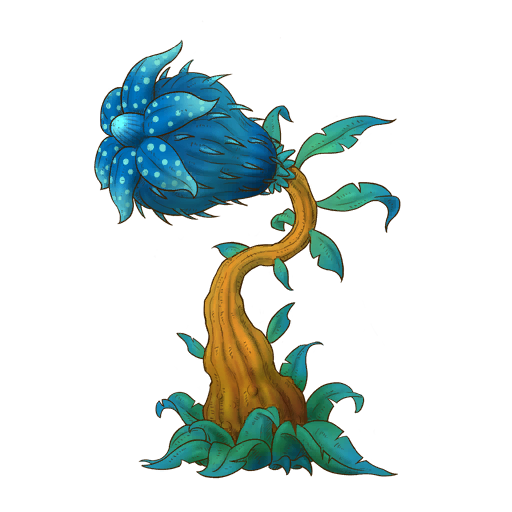
A plant that shoots out seeds similar to cannonballs. The seeds fragment wherever they land, making it highly dangerous.
There are many variants found in each layer, including some which are reported to launch highly poisonous seeds.
They got their name because when encountered, Cave Raiders were often stopped in their tracks. They are also known as “Time-wasters.”
Location: Similar to those of the 1st Layer, these will begin to appear instead throughout some areas of the 2nd and 4th layers, rarely alongside the red variety. These seem easiest to find in Hell’s Crossing in the 2nd Layer, however.
Yomotsubi
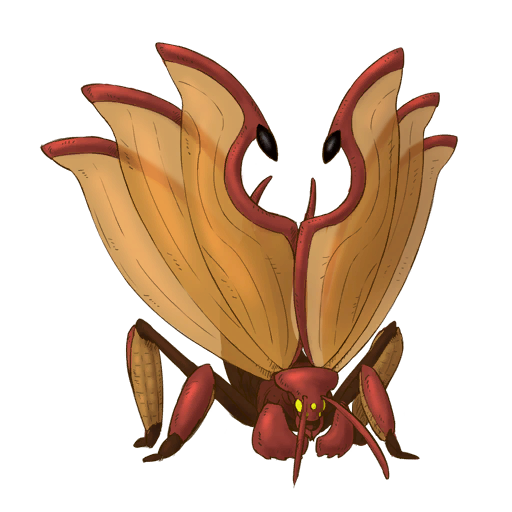
This large bug vibrates its wings to chirp. Its timbre is comforting.
The edges of its wings are partially metal, so the chirping also sounds somewhat metallic.
The wings have three layers with holes in them, which shoots gusts of wind as a means of attack.
Technically it doesn’t attack with the wind itself, but it scrapes its wings together and shoots the metal shavings at its opponents with air stored in its abdomen.
It spreads its wings while projecting air to not only generate metal, but also to detect the wind direction and make it easier to hit its prey.
Although its known for the sparks it emits when scraping off its metal shaving, the wings grow thinner over time, so it’s quite rare to see sparks from one that attacks Cave Raiders.
Although it’s unable to fly, it’s protected with a powerful exoskeleton as if to compensate.
If the wings are damaged, it loses its method of attack and defense.
Location: These deathtraps appear frequently across Hell’s Crossing in the 2nd Layer, waiting to knock you off to your demise if you don’t deal with them carefully.
Yomotsubi (Ancestor)
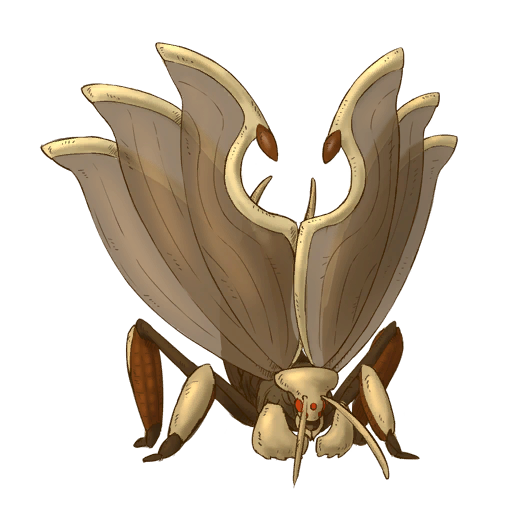
This large bug vibrates its wings to chirp. Its timbre is comforting.
The edges of its wings are partially metal, so the chirping also sounds somewhat metallic.
The wings have three layers with holes in them, which shoots gusts of wind as a means of attack.
Technically it doesn’t attack with the wind itself, but it scrapes its wings together and shoots the metal shavings at its opponents with air stored in its abdomen.
It spreads its wings while projecting air to not only generate metal, but also to detect the wind direction and make it easier to hit its prey.
Although its known for the sparks it emits when scraping off its metal shaving, the wings grow thinner over time, so it’s quite rare to see sparks from one that attacks Cave Raiders.
Although it’s unable to fly, it’s protected with a powerful exoskeleton as if to compensate.
If the wings are damaged, it loses its method of attack and defense.
Location: Within the 3rd Layer, these seem to mostly be in the mines region, looking to knock you off similar to those in the 2nd layer.
Yomotsubi (Rare)
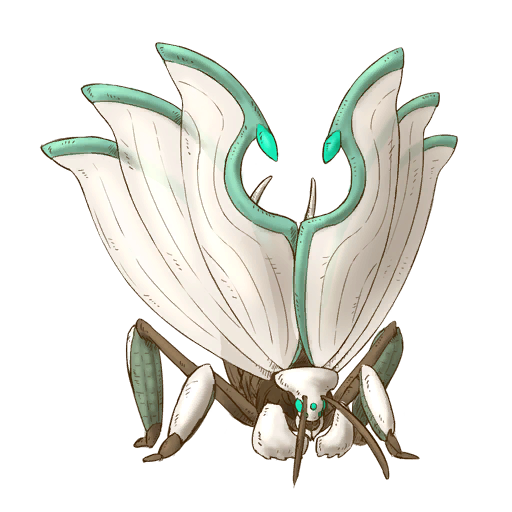
This large bug vibrates its wings to chirp. Its timbre is comforting.
The edges of its wings are partially metal, so the chirping also sounds somewhat metallic.
The wings have three layers with holes in them, which shoots gusts of wind as a means of attack.
Technically it doesn’t attack with the wind itself, but it scrapes its wings together and shoots the metal shavings at its opponents with air stored in its abdomen.
It spreads its wings while projecting air to not only generate metal, but also to detect the wind direction and make it easier to hit its prey.
Although its known for the sparks it emits when scraping off its metal shaving, the wings grow thinner over time, so it’s quite rare to see sparks from one that attacks Cave Raiders.
Although it’s unable to fly, it’s protected with a powerful exoskeleton as if to compensate.
If the wings are damaged, it loses its method of attack and defense.
Location: In the 4th Layer, yet unlike those prior, these don’t spawn in nearly as precarious of spots. They can appear on the large cubic platforms on the way toward the 5th layer entrance in Deep Tree Remains, usually.
Vine-binder
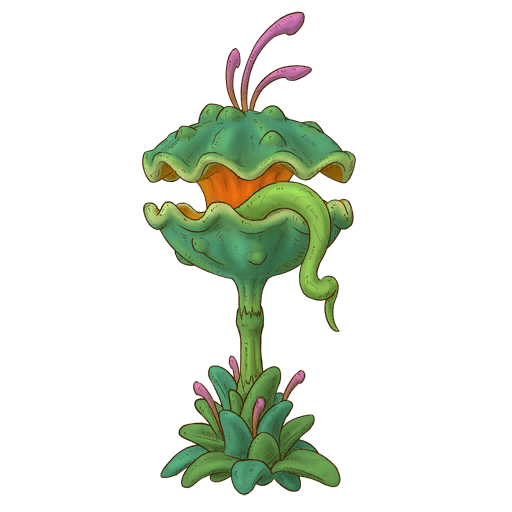
A carnivorous plant that reaches out with its vines to catch prey.
The vines can stretch out long distances and can even be swung around. It is best to keep your distance upon encountering one.
Location: Easily found throughout the 1st Layer, and not uncommon covering some angles of approach in the later layers. One can be found alongside its subspecies closeby in the Stone Ark of the 1st Layer.
Vine-binder (Subspecies)
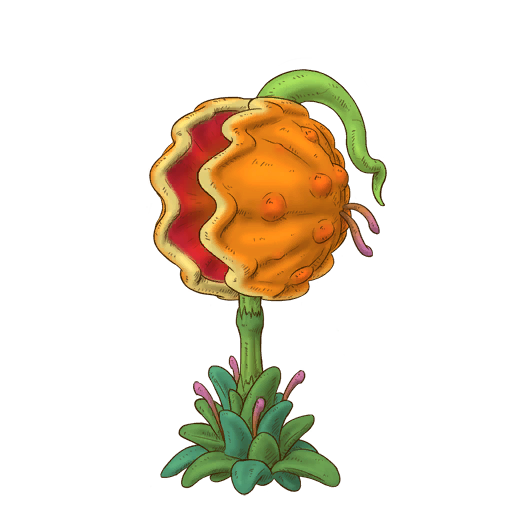
A carnivorous plant that reaches out with its vines to catch prey.
The vines can stretch out long distances and can even be swung around. It is best to keep your distance upon encountering one.
Location: Similar to the regular vine-binder, these appear in places to try and impede passage with their long-ranged attacks. Alongside the regular variety, this can be found in Stone Ark close to its counterpart.
Vine-blaster (Green)
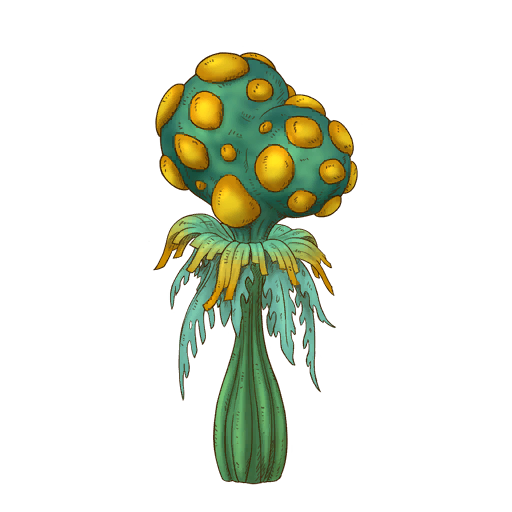
A plant that scatters explosive pollen.
The pollen is scattered around the plant, which then gathers around a Cave Raider before exploding.
Location: Can be encountered in Hell’s Crossing, alongside the blue variety not far away from it.
Vine-blaster (Blue)
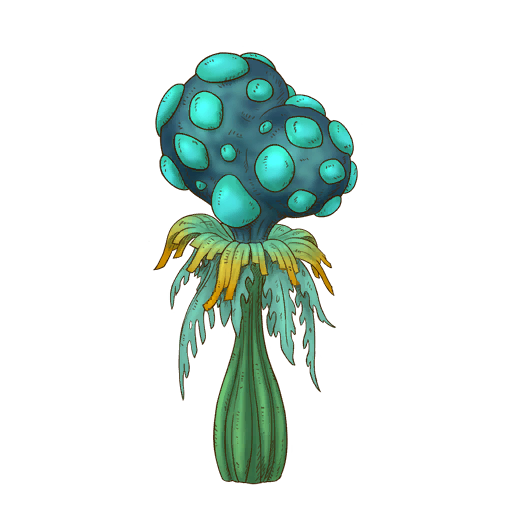
A plant that scatters explosive pollen.
The pollen is scattered around the plant, which then gathers around a Cave Raider before exploding.
Location: Easily encountered in Hell’s Crossing alongside the green variety.
Vine-blaster (Red)
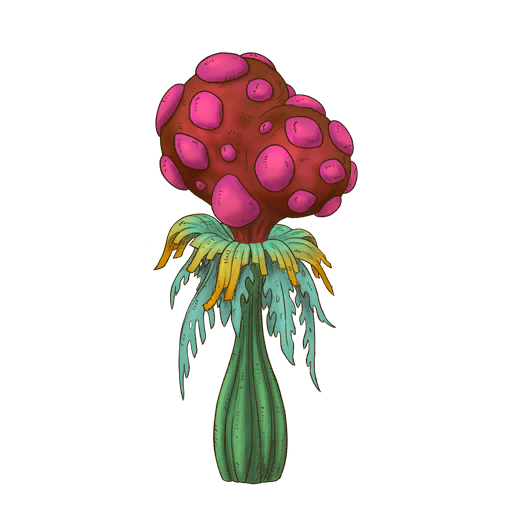
A plant that scatters explosive pollen.
The pollen is scattered around the plant, which then gathers around a Cave Raider before exploding.
Location: Begins to appear on some of the large cubic platform areas in the 4th Layer.
Pupa-carrier
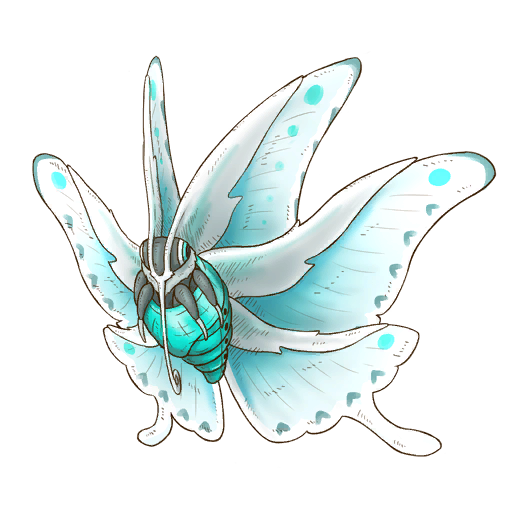
It has beautiful wings and glitters as it sheds scales, flying about aimlessly.
Even after emerging as an adult it continues to live with its pupa. The reason for this is not yet known.
Breathing in its scales causes hallucinations. Caution must be exercised as the more you chase after it, the more scales accumulate in your body.
The pupa is extremely tough and heavy. When in danger, it will discard its pupa to fly at a high speed.
However, once it discards its pupa, it will shrivel up and lose its shine. It must be captured together with its pupa for a sample to be taken of it.
The scales, in small quantities, can be used as a spice. It smells somewhat like cinnamon.
Location: These appear in the first area of the 2nd Layer, and will tend to gather around or obstruct you similar to other pests.
Pupa-carrier (Rare)
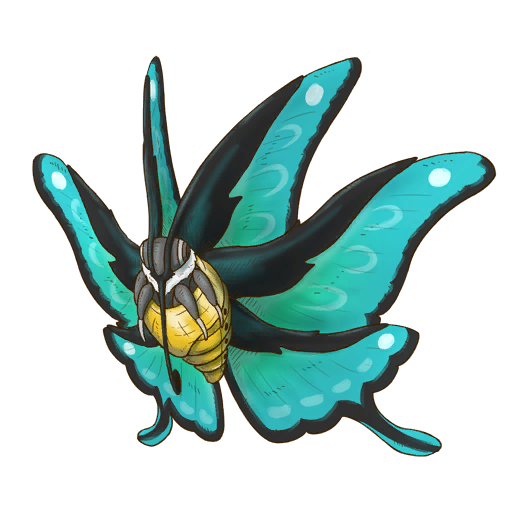
It has a large and beautiful form, so it is taken as a zoological specimen overseas and traded for a high price. It scatters powder with blue poison as it flies, making it difficult to catch.
Location: Similar to the creatures that will obstruct your climbing or movement in previous layers, these will appear to do the same in the 4th and 5th layers alongside other pests.
Spikewalker
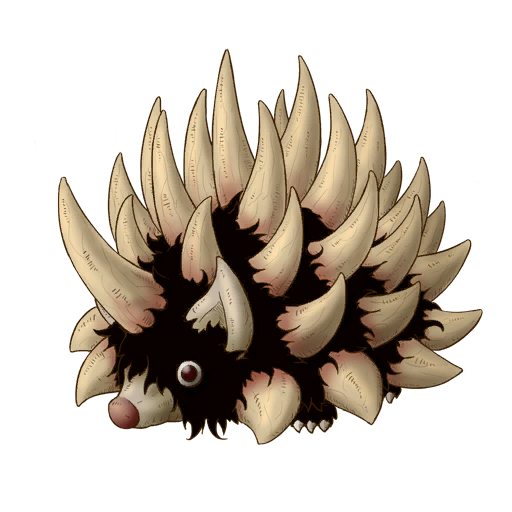
A small creature covered with coarse fur and sharp spikes.
The spikes all over its body cause it to move slowly. However, it has no natural enemies, so it wanders about daily in search of food.
It rarely attacks people, but its sharp spikes can cause terrible damage, making avoiding it the best approach.
It’s not very edible and the meat itself is rather tough, so there is not much benefit for other creatures to attack it.
There are types that remain on the ground as well as types that live along the walls.
Possibly due to its feeding habits, its body color and features can differ.
Location: Along much of the tree limbs paths in the inverted areas, or outside the seeker camp, in the 2nd Layer.
Inbyo
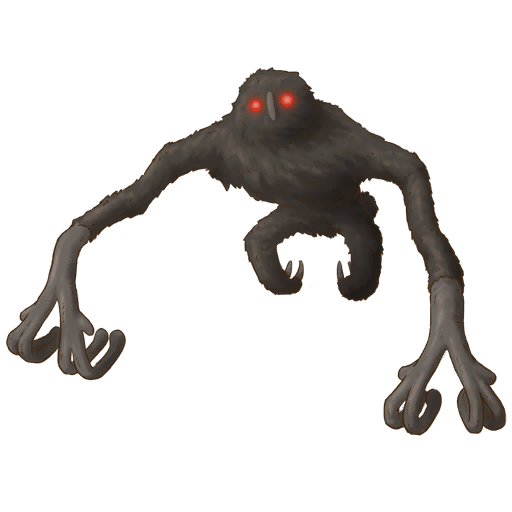
An ape-like primeval creature that lives in the Inverted Forest of the second layer. It threatens those who intrude in its territory by throwing rocks at them.
Location: They will usually show up in the smaller unreachable hanging tree platforms of the 2nd Layer, throwing rocks at you if you get too close.
Valley Croaker
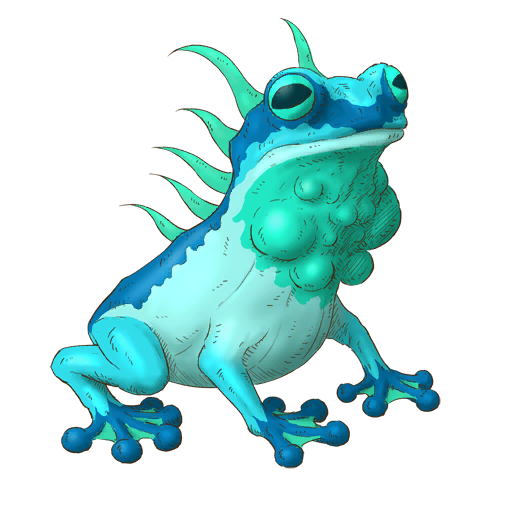
An amphibian that lives in the marsh of the second layer.
It has large webbed feet, it spreads its legs in midair to briefly glide.
Its throat has multiple bag-like structures where it stores poison.
It jumps up to spew poison. It then jumps again to move through the air. It uses this acrobatic movement to approach its prey before performing a body slam.
Caution must be practiced when it expands its throat and makes a croaking sound, for it is preparing to spew poison.
If the throat is properly extracted, it can be used as a poison bag.
The meat tastes terrible.
Location: In the small areas at the Edge of the Abyss in the 2nd Layer, interchangeably with Ottobas appearing.
Valley Croaker (Jumper)
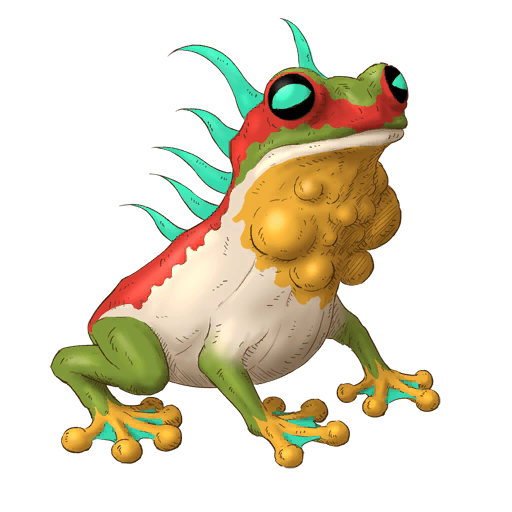
An amphibian that lives in the marsh of the second layer.
It has large webbed feet, it spreads its legs in midair to briefly glide.
Its throat has multiple bag-like structures where it stores poison.
It jumps up to spew poison. It then jumps again to move through the air. It uses this acrobatic movement to approach its prey before performing a body slam.
Caution must be practiced when it expands its throat and makes a croaking sound, for it is preparing to spew poison.
If the throat is properly extracted, it can be used as a poison bag.
The meat tastes terrible.
Location: Can appear randomly after previous croakers have been killed, but spawns naturally in the Heaven’s Waterfall along the slope.
Valley Croaker (Extreme)
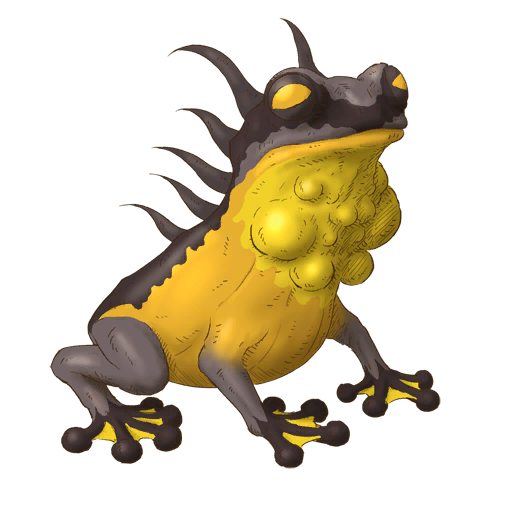
An amphibian that lives in the marsh of the second layer.
It has large webbed feet, it spreads its legs in midair to briefly glide.
Its throat has multiple bag-like structures where it stores poison.
It jumps up to spew poison. It then jumps again to move through the air. It uses this acrobatic movement to approach its prey before performing a body slam.
Caution must be practiced when it expands its throat and makes a croaking sound, for it is preparing to spew poison.
If the throat is properly extracted, it can be used as a poison bag.
The meat tastes terrible.
Location: Tends to appear in Heaven’s Waterfall on the 2nd Layer after a few Jumper Croakers have been killed.
Giant-hammerbeak
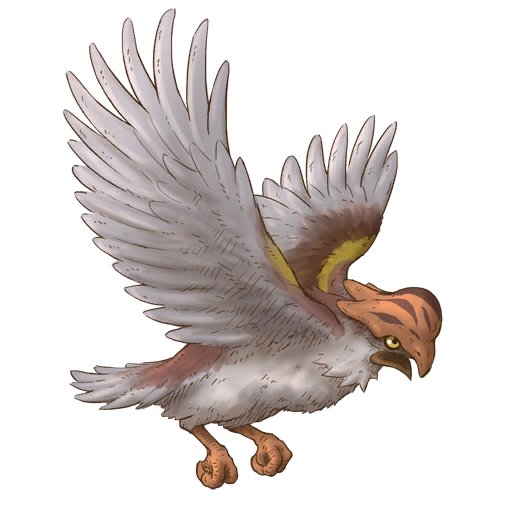
A bird that inhabits a wide range, from the surface to the fourth layer of the Abyss. It has a hard skull that is fused with its beak. Its wingspan is over three meters long.
Males clash with each other using their skulls. The impact of their skulls can literally cause sparks to fly.
Its meat is delicious and prized among Cave Raiders. The skull can be used as a fire starter, cooking utensils, and a bowl. It is said that one of these is enough for all your cooking needs.
Its feather can be used as high-quality kindling.
Location: Despite its description (being the same as the regular hammerbeak), it appears to only spawn in the Seekers’ Camp area, and Inverted Arbor in the “hidden” area with man-toyers.
Ottobas
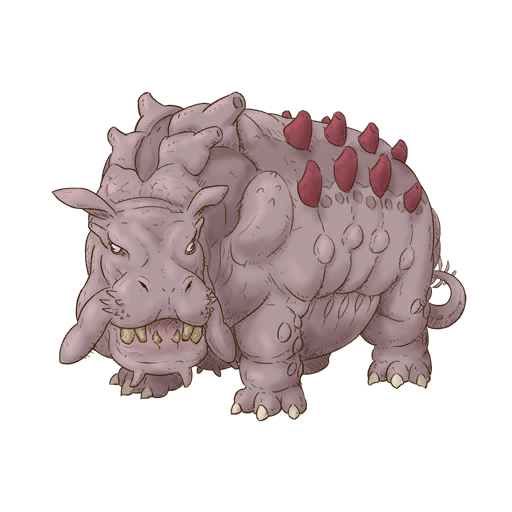
This large, aquatic animal lives at the bottom of the second layer in the Inverted Forest.
An animal brought from overseas that miraculously survived in the Abyss. It was the king of jungle rivers back in its homeland.
They are vulnerable to the prevalent predators of the Abyss, and soon were chased to the deep parts of the Inverted Forest, where the force field is weakest.
Its harsh appearance mimics other creatures from where it originally lived.
After being chased to where they now live, they’ve increased in size over time. They are omnivorous and can swallow humans whole.
Its skin and fat layers are extremely thick and not fit for consumption. However, if it can be properly cleaned and processed, it contains enough delicious meat to feed 200 people.
Location: Edge of the Abyss, near the entrance to Terminal Pond, these can appear randomly.
Corpse-weeper
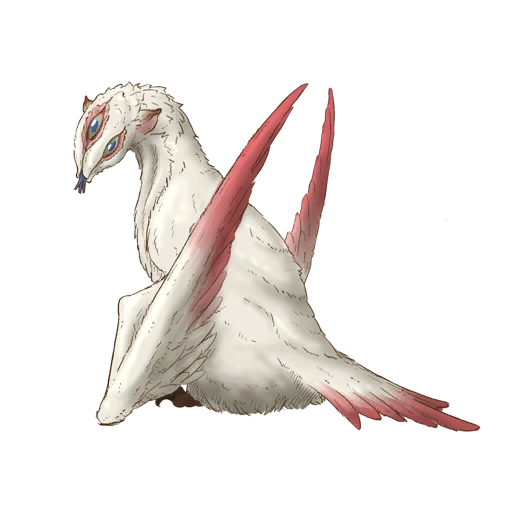
A large bird that inhabits the second layer of the Abyss. It uses advanced sound mimicry to attract prey.
It lives in large colonies where they nuture the young as a whole. Despite its appearance, it can be caring. It can be tamed by humans if reared while still a chick.
It has no beak; its evolved tongue can suck out the innards of its prey. Some have a wingspawn of 10 meters from end to end. It can easily lift up adult humans.
Location: As the area name suggests, these most often fly in the air at the Corpse-weepers’ Den, though they can appear randomly in the Forest of Temptation, too.
Head-tail
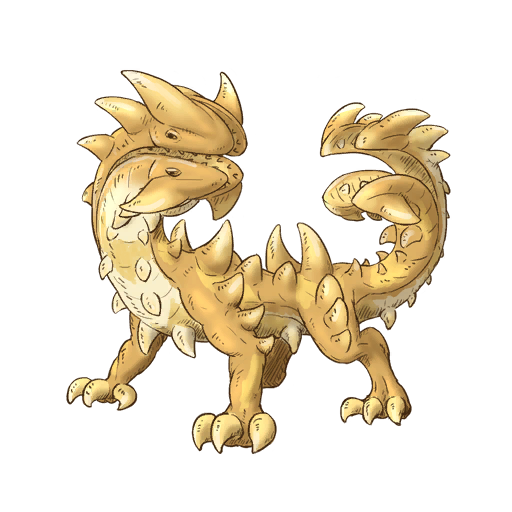
The head and tail have similar shapes and move in similar ways, making it difficult to tell them apart.
Countless Cave Raiders have been confused before getting killed.
It has spiky scales which it shakes and rubs together. Its tail stores electricity inside, which it uses to shock targets.
Its mouth is split into four parts, making its bite extremely dangerous.
Although barely any of it is edible, its meat is shockingly delicious.
Location: Aside from one you can encounter as part of a sidequest, they can appear in the hidden hot spring at the 4th Layer.
Head-tail (Subspecies)
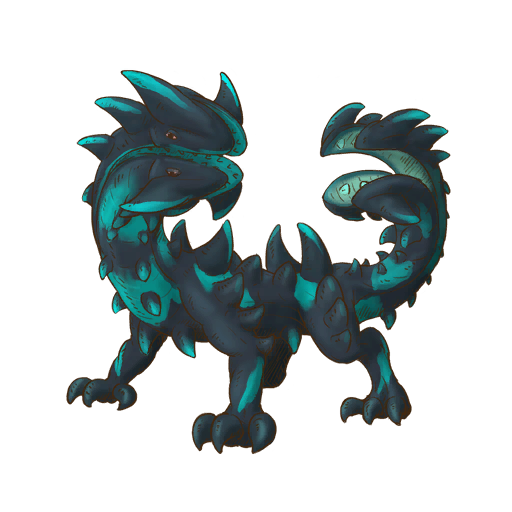
The head and tail have similar shapes and move in similar ways, making it difficult to tell them apart.
Countless Cave Raiders have been confused before getting killed.
It has spiky scales which it shakes and rubs together. Its tail stores electricity inside, which it uses to shock targets.
Its mouth is split into four parts, making its bite extremely dangerous.
Although barely any of it is edible, its meat is shockingly delicious.
Location: Similar to the water-covered floor regions the regular ones spawn on, these spawn on water-covered areas within the sea of corpses, often near the entrances of the area.
Rock-licker
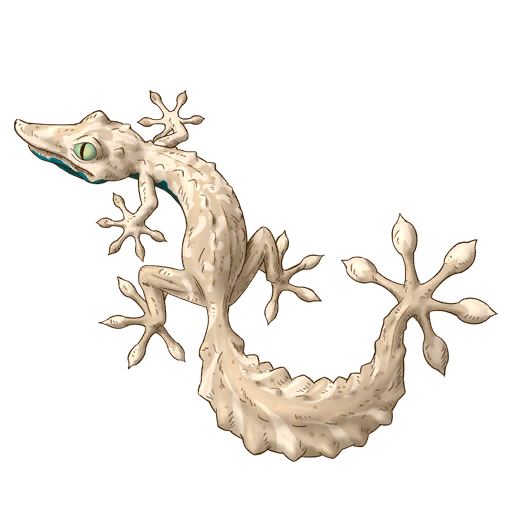
This creature has a reptilian appearance and lives on cliff walls.
It extends its tongue to attack, and swings its tail to strike at enemies behind it.
Location: Often on the walls of the caves in the 3rd Layer, to obstruct or attack you whilst you climb, though not outside in the fault’s open-air walls themselves.
End-jumper
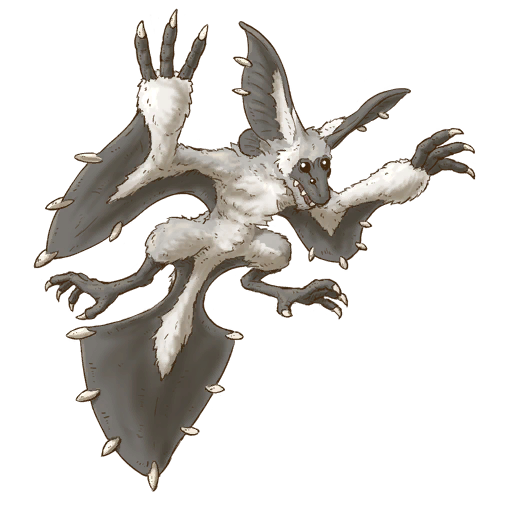
A small creature with webbing between its front and rear legs. It uses its webbing to glide through the air.
It has no eyes, but it has an organ similar to horns which detects both sound and the force field, allowing it to navigate even in the dark.
It attacks by using sharp claws or by biting. It can spin its body and then swing its expanded tail.
It attacks Cave Raiders and adds their items to its nest.
Location: Appear most often on the walls of the fault int he 3rd Layer, but can appear sometimes in the goblet of giants on some climbable portions as well.
Neritantan

It has a flat body and looks like a rodent.
It has four protrusions on its back but no one knows what they’re for.
It has ribs that can easily shift shapes, allowing it to become thinner or even to hold more air.
Typically, it is harmless to humans. Its long fur is often used as a blanket.
They live in the walls of the third layer, and have a symbiotic relationship with the plants there.
They mainly eat fruit and have a preference for a fruit called barachocha. Its flesh is tasty and can be used in a variety of dishes.
Location: Quite nearly instantly upon entering the 3rd Layer from the entrance blocked by the Inter. Device. Very common throughout otherwise. They scream at you.
Rock-walker
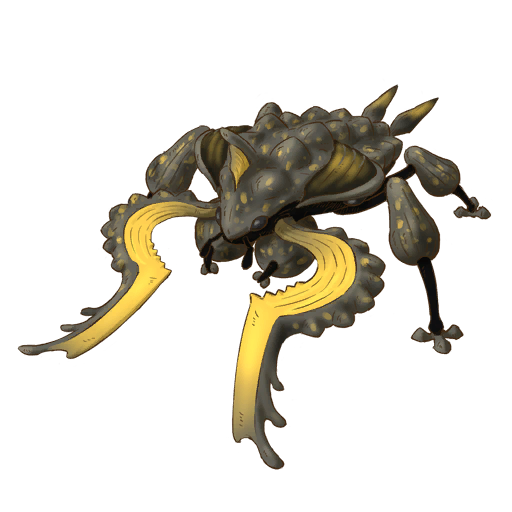
A large bug with massive jaws. It lives on the walls in the third layer.
It uses its huge jaw to scoop up or clamp down.
Location: Despite its description, this creature does anything but live on the walls, more often appearing from behind to bite you while you consider climbing, or while fishing in the goblets at the 4th Layer.
Amakagame
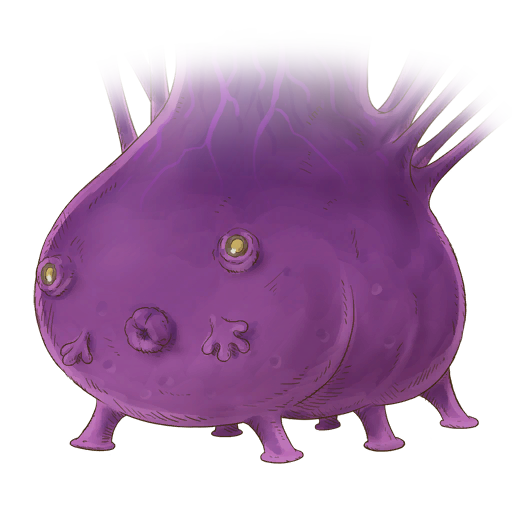
A creature that resembles a huge plant and lives in caves.
It smells like the barachocha plant to lure in prey, then swallows it whole to digest.
It emits a bizarre groan when shocked.
Location: A portion of the stone pillars area in the 3rd Layer has a few of these, if you fall into one from the topside of them, ‘finishing the encounter’ with one will give you its entry.
Madokajack

It creates holes on the side of the Great Fault in the third layer and lives in colonies.
It spreads its membrane to glide around the Great Fault and feeds on other creatures that live along the walls.
Location: Flying around frequently in most maps that feature the open-air portion of the 3rd Layer, these creatures will swoop to easily knock you from the wall whilst climbing, and probably kill you outright.
Crimson Splitjaw
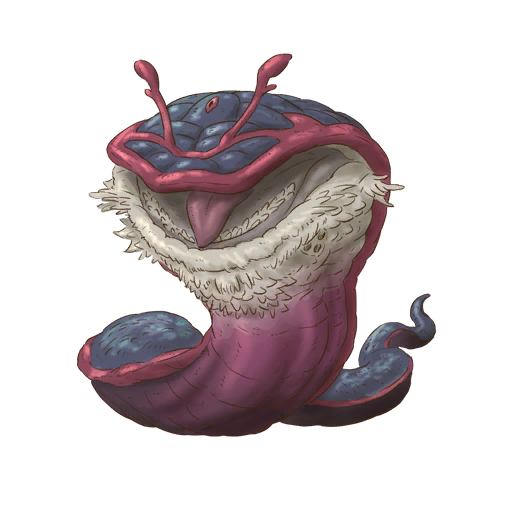
A red, snake-like creature that nests at the cliffs in the third layer of the Abyss. It spreads its membrane to ride air currents, crossing the other side of the cliffs.
It attempts to eat Relics and mineral ore. Whether as nutrition or to train its gizzard remains unknown.
The three black dots around its mouth are organs that can detect the force field.
Its meat tastes terrible.
Location: A few can be found sometimes in the lower areas of the 1st Layer, as well as the updraft area in the 2nd Layer, despite the region listing. One also appears in the glass layer of the 3rd layer, in a room that you visit for a side quest.
Amaranthine-deceptor
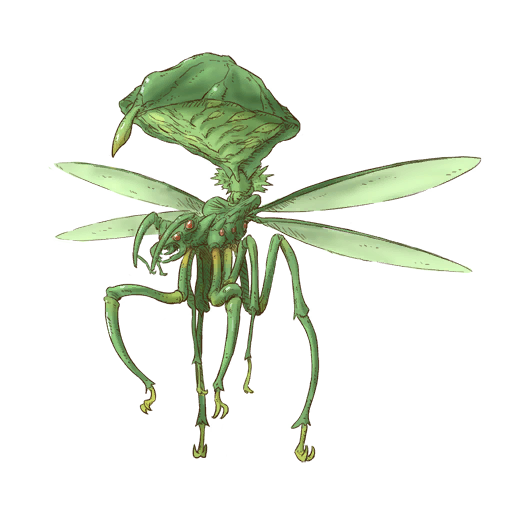
A flying bug that lives in the sixth layer of the Abyss, territory of the unreturned.
It mimics the appearance of Eternal Fortunes, then attacks creatures that approach it. It lays its larvae in its prey.
The prey has its head devoured while still alive, serving as living food for the larvae. The adult specimens are said to be edible.
Location: These can appear in fields of flowers fortitude randomly, indicated by a buzzing and music change as they begin to attack you.
Shroombear

It has parasitic water-shrooms growing on it. When the host is dying, the shrooms share absorbed nutrients to keep it walking (which also prevents flesh from rotting). This symbiotic relationship with shroombears allows them both to increase in numbers.
Location: Immediately upon entering the 4th Layer.
Light-eater
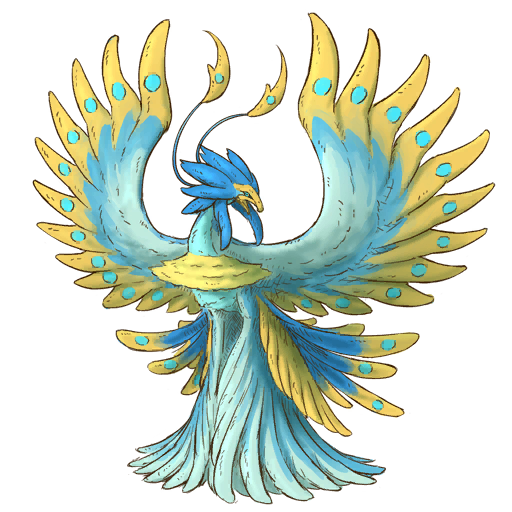
A bird that looks beautiful when it spreads its wings. Despite how it looks, it can barely fly.
Its legs are fused with the tail feathers, serving as a sort of wing, and it uses its tail to stand.
It can’t walk normally, but rather flaps its wings to slide around and can also use them to jump short distances.
It moves its wings in a sweeping fashion to launch feathers as an attack.
The feathers are structured like thin, layered scales, and are capable of consecutively launching one after another.
The underside of the tail feathers feel like a soft bed, which they use as a nest to rear their young after laying their eggs. They remain mostly motionless until their eggs hatch.
The females protect the nest and young while the males gather food.
Location: In the 4th Layer, one appears in floating rocks and the crystal valley, sitting in the same spot each time.
Mountain-spinner
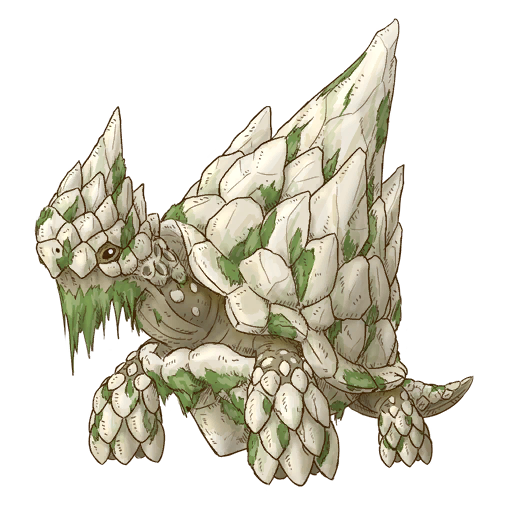
A creature that looks like a rock and lives in the holes of the third layer.
It remains so still that moss grows over its body. Many Cave Raiders do not notice it.
It compresses inhaled air and stores it in its body, blowing it out beneath its feet to propel itself like a top.
It is covered with rock-like scales and a shell, but the area between its lower jaw and neck has exposed skin that’s relatively soft.
Its ability to store and propel air was originally used underwater to dig through the sea floor, as well as to destroy obstacles to find food.
Location: Throughout the 3rd Layer, but particularly not in the cold/hot regions, where the other two spawn instead.
Mountain-spinner (Fire)
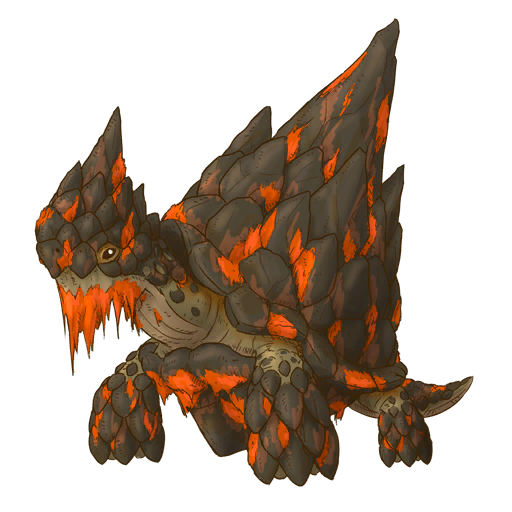
A creature that looks like a rock and lives in the holes of the third layer.
It remains so still that moss grows over its body. Many Cave Raiders do not notice it.
It compresses inhaled air and stores it in its body, blowing it out beneath its feet to propel itself like a top.
It is covered with rock-like scales and a shell, but the area between its lower jaw and neck has exposed skin that’s relatively soft.
Its ability to store and propel air was originally used underwater to dig through the sea floor, as well as to destroy obstacles to find food.
Location: In the 3rd Layer, often in the colder areas, or in the rock pillars area.
Mountain-spinner (Ice)
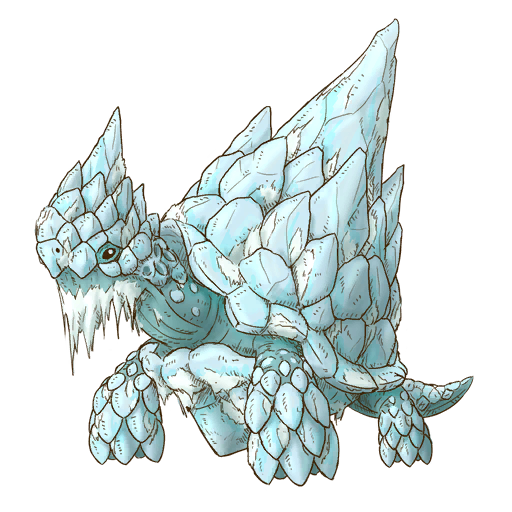
A creature that looks like a rock and lives in the holes of the third layer.
It remains so still that moss grows over its body. Many Cave Raiders do not notice it.
It compresses inhaled air and stores it in its body, blowing it out beneath its feet to propel itself like a top.
It is covered with rock-like scales and a shell, but the area between its lower jaw and neck has exposed skin that’s relatively soft.
Its ability to store and propel air was originally used underwater to dig through the sea floor, as well as to destroy obstacles to find food.
Location: Within the 3rd Layer, often in the colder areas, and the stone pillars area.
Kudara
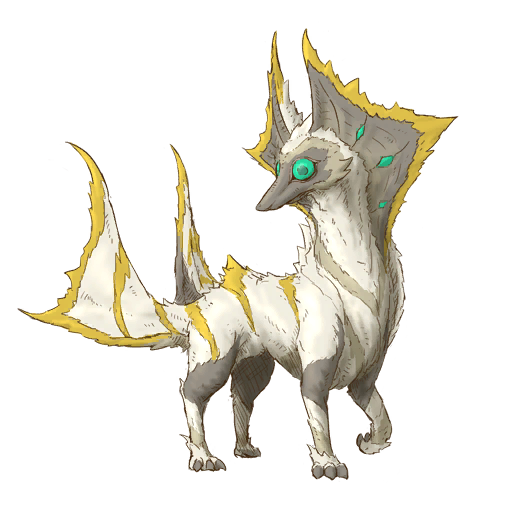
The creepy big eyes, large folds for ears, and tails give this four-legged creature a distinct appearance.
It emits a special light from its ears, which produces a sharp glare to confuse those who approach, resulting in a hallucination of seeing double.
It refrains from fighting among its own species and commonly hunts in packs.
It calls for backup while distracting targets with hallucination. When their numbers grow too big, they can become an overwhelming force.
Its fangs have a paralyzing poison, making it extremely difficult to flee once bitten.
Its name “Kudara” comes from the Japanese etymology of “one hundred.”
Location: After their introductory scene, these can be found in the Eternal Fortunes in the 4th Layer.
Kudara (Shadow)
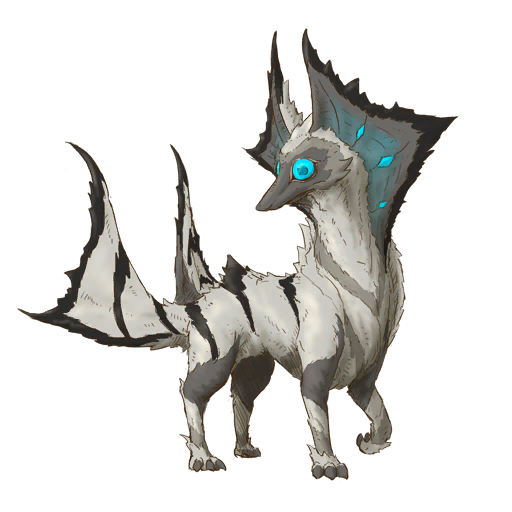
The creepy big eyes, large folds for ears, and tails give this four-legged creature a distinct appearance.
It emits a special light from its ears, which produces a sharp glare to confuse those who approach, resulting in a hallucination of seeing double.
It refrains from fighting among its own species and commonly hunts in packs.
It calls for backup while distracting targets with hallucination. When their numbers grow too big, they can become an overwhelming force.
Its fangs have a paralyzing poison, making it extremely difficult to flee once bitten.
Its name “Kudara” comes from the Japanese etymology of “one hundred.”
Location: Can be encountered throughout a few of the maps in the 5th Layer.
Orb Piercer

A large beast that lives in the Flat-Creeper Spike Stretch in the fourth layer.
It is an herbivore that eats the algae off the flat-creepers. However it is extremely aggressive. A single creature has either killed or severely injured over 100 Cave Raiders.
The Flat-Creeper Spike Stretch is an important cave-raiding route, but an orb piercer considers the entire 1000-meter diameter its territory.
The spikes around its body contain a fatal poison. It also seems able to predict the future (as the organ on its head can detect the force field, which is used to predict its opponent’s movement). It moves quickly, even in shallow water.
It was first dubbed the “toka deer,” but given its ability to pierce everything, the name “orb piercer” stuck.
Location: These will sometimes wander inside the bowl-like structures of the flat-creepers within the goblets, or on the cubic shaped areas farther down in the 4th Layer. Their aggro range is quite large.
Octoliar
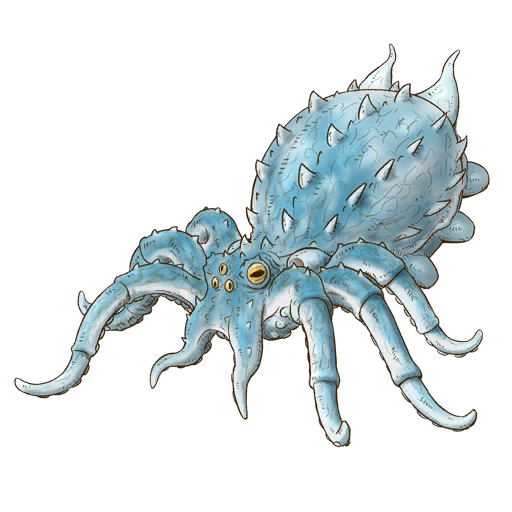
Its ecology and movements are similar to a spider’s, but its body and appearance are like an octopus.
It cannot walk very fast, but can temporarily increase its speed by exhaling air.
It mainly lives inside holes along walls. Its body is colored similarly to its environment as a form of camouflage. This makes it difficult to be seen from far away.
When danger approaches, it emits poisonous gas to protect itself. The gas lingers in the air, similar to ink from an octopus.
Location: A few spawn around the sea of corpses maps themselves, but the largest amount are definitely in Sea of Corpses 1, at the large towering structure near the middle point of the map.
Swarm-shocker (Blue)
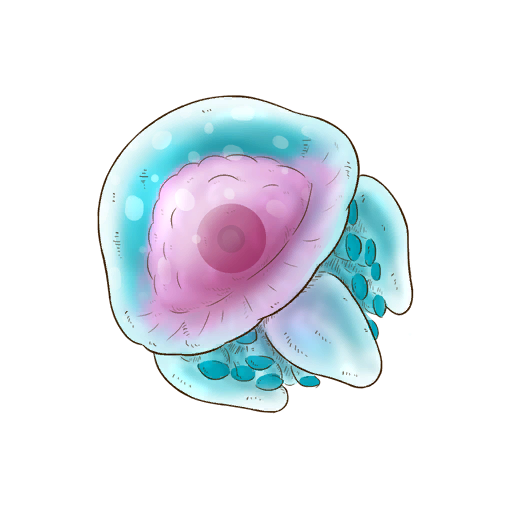
A mollusk creature that can float in the Abyss. It appears in a swarm, but is rarely aggressive.
The swarm emits a powerful electric shock when touched or struck.
Location: These enemies serve as pests for spending prolonged time in the 5th layer, but can also spawn naturally in small groups.
Swarm-shocker (Purple)
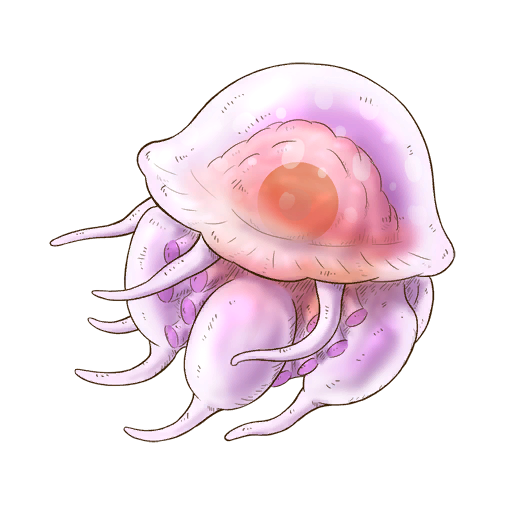
A mollusk creature that can float in the Abyss. It appears in a swarm, but is rarely aggressive.
The swarm emits a powerful electric shock when touched or struck.
Location: They spawn somewhat interchangeably with the blue variety, but tend to spawn often in Water Crystals areas.
Swarm-shocker (Orange)
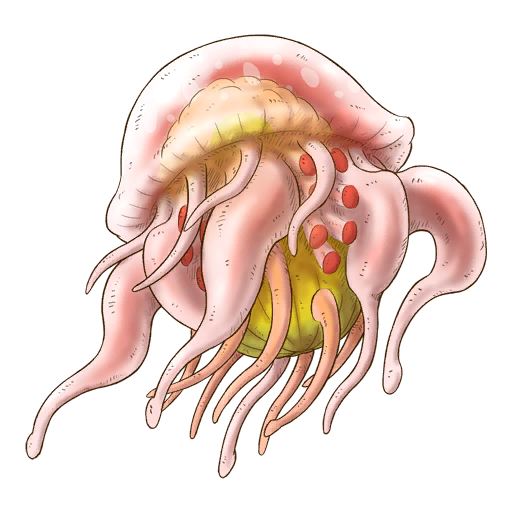
A mollusk creature that can float in the Abyss. It appears in a swarm, but is rarely aggressive.
The swarm emits a powerful electric shock when touched or struck.
Location: The largest of the Swarm-shockers, the frequently spawn when travelling through Water Crystals 1 and 2 in pairs.
Footing-slicer
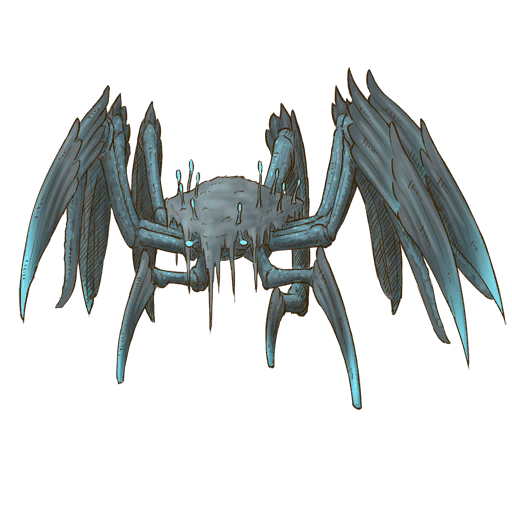
A primeval creature with nine legs. It uses six of its claws on the side to hunt prey while the remaining three legs walk.
It keeps its claws exposed even while asleep, prepared for an attack, which makes it look like a towering pillar from a distance.
If you can ride it, it will aid you in reaching higher places, as well as provide you with a means of transportation.
The six claws cover a rather wide area. While it cannot attack very quickly, because its attacks are unpredictable, caution must be exercised when approaching it.
Its shell is extremely hard, so you must aim for its joints, though it is difficult as the large claws get in the way.
The best approach is to rush its torso region and aim at the joints of legs used for movement.
There are moss-like plants growing on its back.
Location: Can be found standing still and upright in Sandy Ice areas, randomly giving access to one of the plateaus in the area at a time.
Footing-slicer (Young)
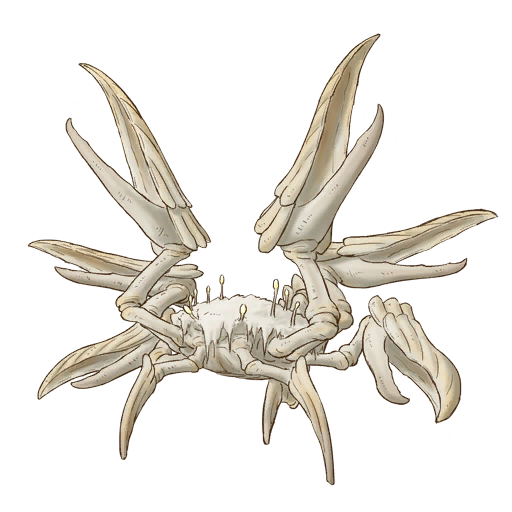
The footing-slicer dwells in the fifth layer, but moves up to the fourth layer during breeding season. They plant their eggs inside flat-creepers and die once doing so. By planting eggs in the warmer, more accessible fourth layer, it increases the chance of its spawn surviving.
Location: Immediately upon entering the 4th layer, outside the cave there should be a fishing pool nearby with them sitting in it.
Stingerhead
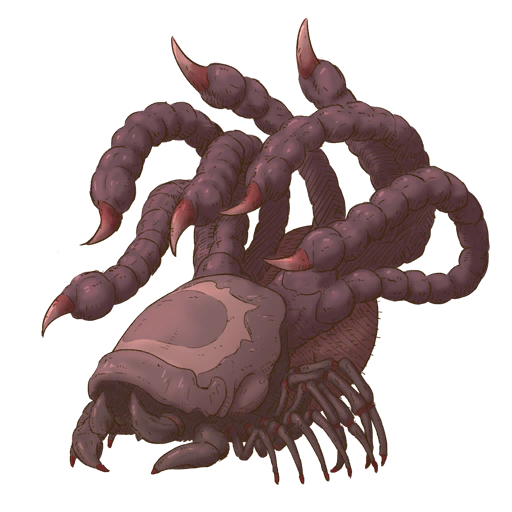
Located in the fifth layer’s Sea of Corpses Sandstone Region is this aggressive bug, which has seven tails and is two meters long. Each tail contains poison that can melt flesh and bone.
The area around their nests have a distinct odor. According to Lyza’s letter, “It’s akin to the smell produced when vomit is dried out and burned. Their meat is not fit for consumption.”
Location: When passing through the Sandy areas, some areas of the ground will begin to quake and crack; be sure to get off them in time or you’ll get an instant death cutscene, but avoid it and they’ll be sitting inside before eventually burrowing away.
Tidal-freezer
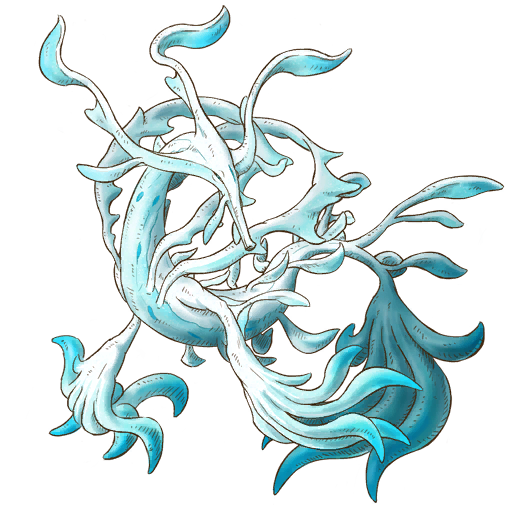
A large floating creature in the Abyss that is covered in diamond dust.
Its blood and bodily fluids don’t freeze even in extremely low temperatures. The fins emit cold energy as a means to regulate body temperature.
The cold energy emitted from its body is powerful, freezing the water particles in the air around it and creating small ice shards.
It can swing its body as a form of attack.
Liquid launched from its mouth turns into blocks of ice, which is also used as an attack method.
Unlike most creatures, the more it moves, the lower its body temperature is reduced until it reaches a certain point where it freezes.
The guts are like a natural freezer, making them highly prized.
While it has the ability to freeze an entire area, doing so would reduce its own body temperature too much, freezing itself.
Location: Appears randomly in the Water Crystals areas, on a larger platform.
Ink Flower
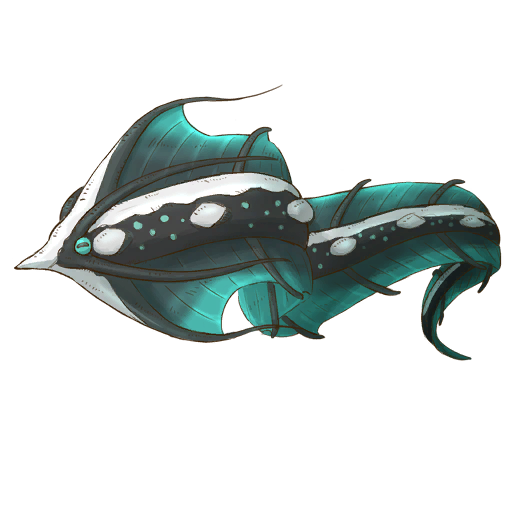
A large, floating creature that elegantly and lazily flies about.
The fin and tactile organs are fused together to sense both airflow and the force field. It is an important part of its anatomy used for movement and as a sensor.
The head portion is extremely tough.
When viewed from the front, the whiskers and fins point in six directions. It folds down its fins and whiskers when moving at high speed.
It expels air from what looks like gills at regular intervals, making it possible to fly at a fast speed or to suddenly change directions. It is exceptionally good at ramming their enemies where they least expect it.
Location: Can appear randomly in a few areas of the 5th Layer, swimming lazily through the air. In particular it can spawn in Ido Front, and Sea of Corpses 1 and 2.
Ink Flower (Young)
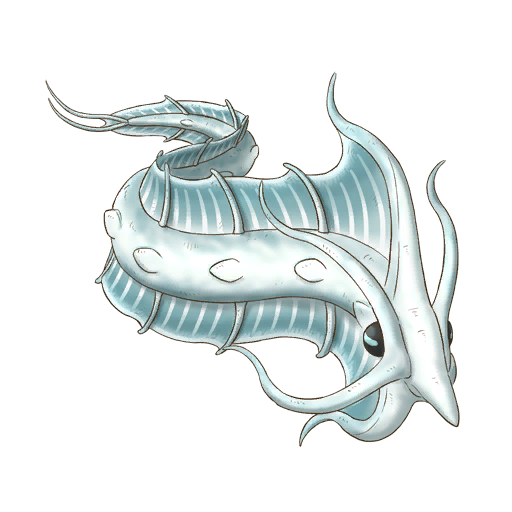
The ink flower is a dangerous primeval creature that is capable of flying. Immediately after being born, they live underwater and are very weak.
Location: Within the fishing pools at hail jail, or outside Ido Front, you can see them swimming around.
Inter. Device
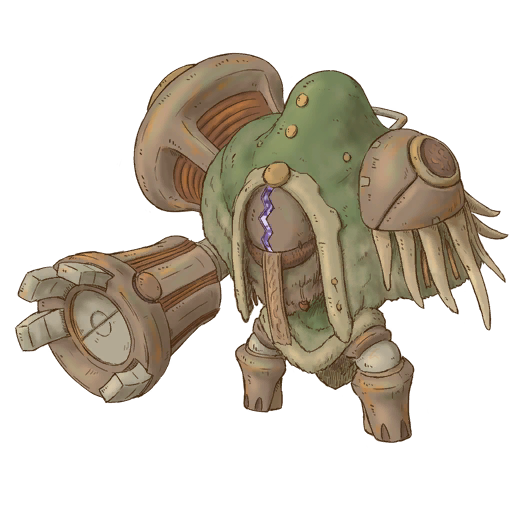
An interference device left at the first layer. It emits a powerful beam from its right hand. It is extremely tough.
Location: Appears outside the entrance to the 2nd layer during the respective quest to reach the bottom of the 1st layer. Its entry will be added automatically afterwards.
Inter. Device
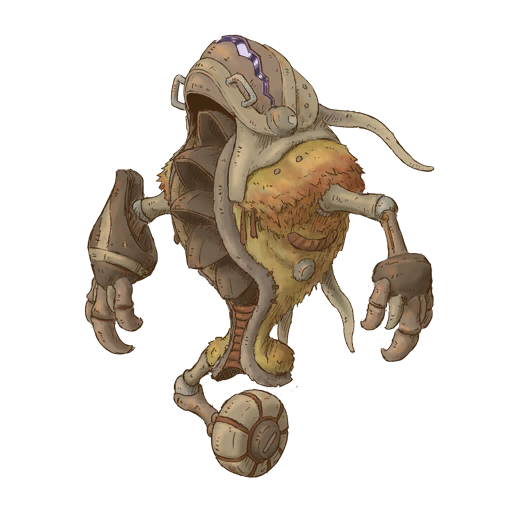
An interference device left at the second layer. There are wheels equipped on the abdomen and legs, giving it high mobility.
Location: It will does not block your way into the 3rd layer, but the uppermost entrance into the great fault does not appear until after you deal with it. Its entry will be added automatically.
Inter. Device
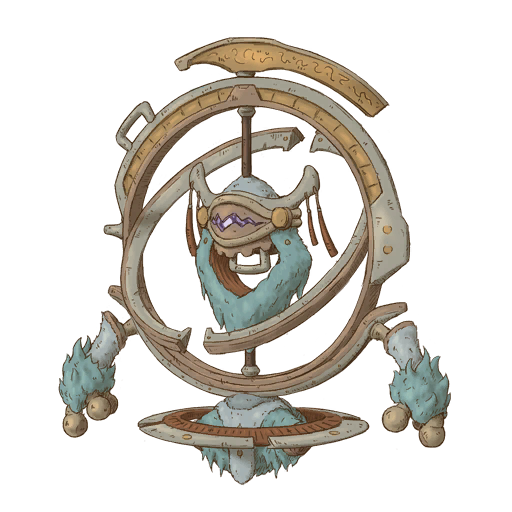
An interference device left at the third layer.
It does not appear to be like any living creature. Its structure is like a spinning top, making its body resemble a giant antenna.
Location: Blocks your way into the 4th layer. Its entry will be added automatically after encountering it.
Inter. Device
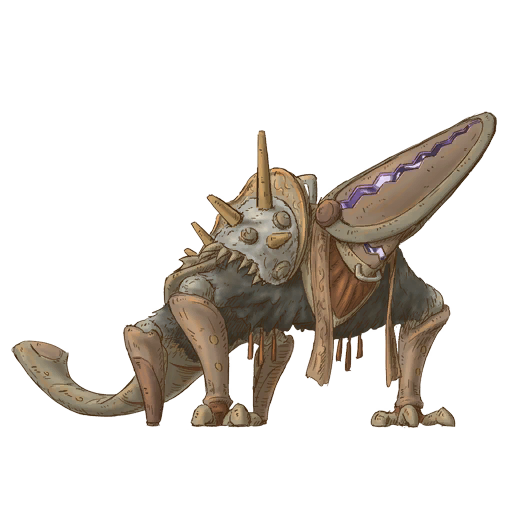
An interference device left at the fourth layer.
The stick part extending from its shoulder is assumed to function like some sort of sensor.
Location: Blocks your way into the 5th layer as an encounter. Its entry will be added automatically afterwards.
Inter. Device
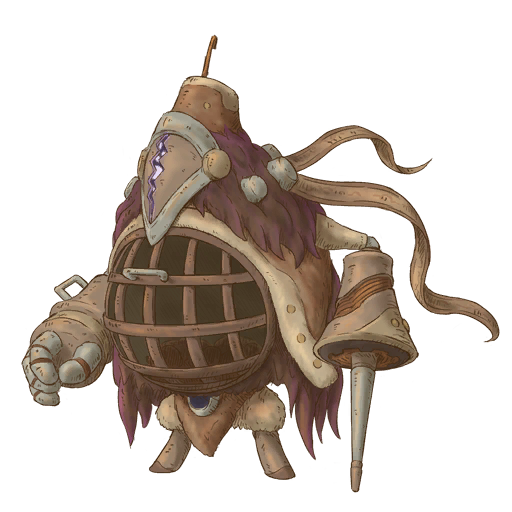
An interference device left at the fifth layer. It has a whip.
The stomach part is a storage space made to store something, but due to its erosion, its purpose cannot be verified.
Location: While in the 5th layer, it has a chance to appear in a random encounter similar to foreign raiders while in the sandy ice areas or hail jail. Its entry will be added automatically after encountering it.
Gankimasu
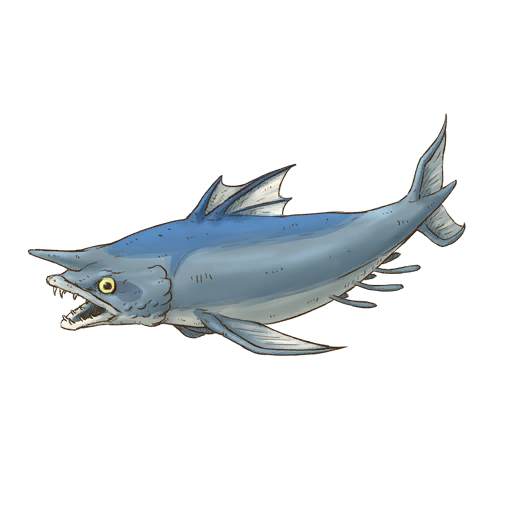
A common fish found from the surface to the fourth layer. A fish treasure by all Cave Raiders. The fish grow smaller at each lower layer. However, they taste the same.
Location: As suggests, they’re basically everywhere, though they do in fact tend to show up less at lower layers (probably due to other fish spawns taking priority.
Ikenosuke
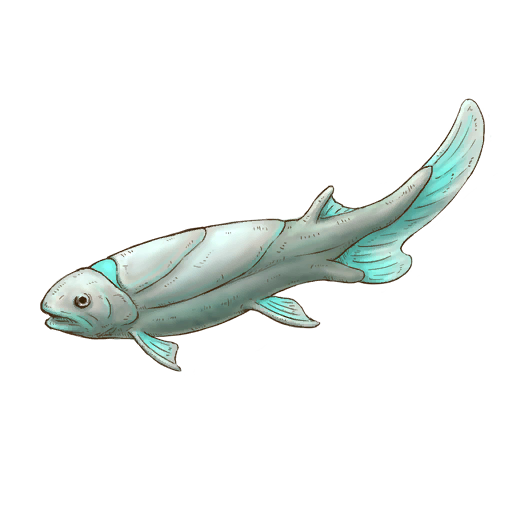
A fish found in the lakes of lower layers. Instead of scales, it has tough, white skin. The taste of its meat has a slight, sweet flavor.
Location: You can find these as early as the 2nd layer, in the fishing pool at the Corpse-weeper Den. They stand out by being lighter than the other fish, but not as pale as the (young) fishables.
Tenkoume
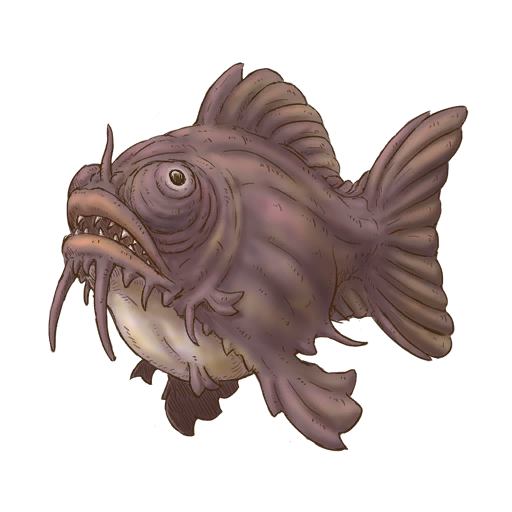
A large fish common in the center layers. It prefers dark water and has intimidating marks on its body. Its whiskers function as eyes.
Location: Inside the caves of the 3rd Layer, there’s a fishing pool near the backside that can have these in it, as well as in Freezing Hot Mines, though they can appear in lower layers pools as well.
Hagamizukin
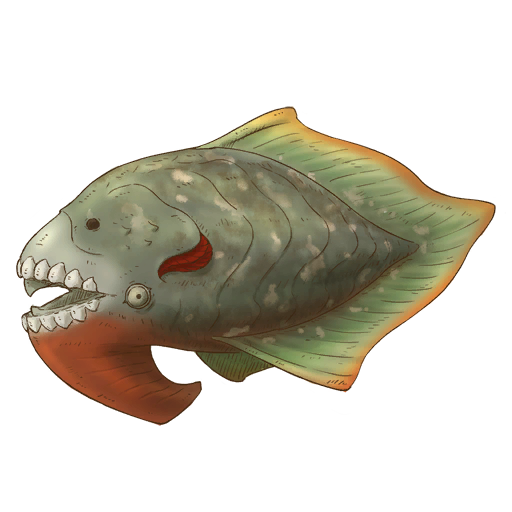
A strange fish with teeth similar to land animals. In order to catch its prey, they emerge from water at intense speeds. Not much else is known about them. Given how rare they are, they are considered to be legendary fish.
Location: In the same pool you can find young footing-slicers, one will often be there, but you can also find a few in the 5th layer, as well.
Hamashirama
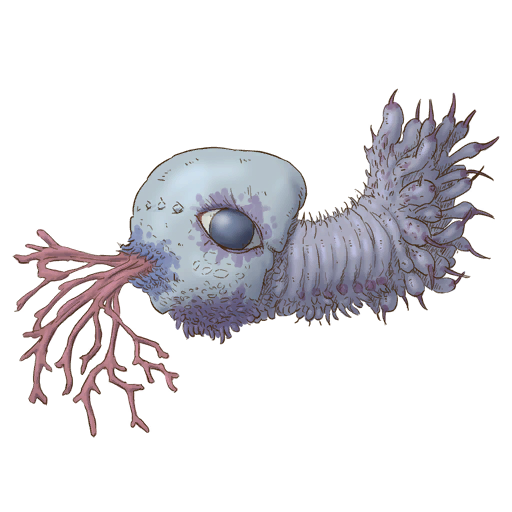
A peculiar-looking fish found in the fifth layer. Rumor says that they feed on life force itself. Its intestines are all located in its head.
There have been some reported of them releasing their sticky intestines as a way to slow down and fend off potential predators.
Location: As the entry suggests, they’re found within fishing pools on the 5th layer, in Sea of Corpses 2 and out front of Ido Front.
